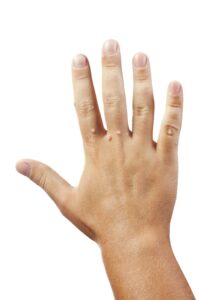
Warts are a skin condition that occurs when one of over 100 different types of the highly contagious Human Papillomavirus (HPV) come into contact with an open cut, even a very small one, and the cut becomes infected. While warts are benign and often harmless, without wart treatment they can easily spread to other parts of your body, or you can even infect those around you. Warts can be embarrassing, painful and itchy, and it’s important that you have wart treatment to prevent the spread of warts. This blog post will inform our patients on the types of warts, and when to seek wart treatment at Dr. Perri’s offices.
Common Warts
Common warts are rough and grainy in appearance and often have a pattern of tiny, black dots, which are small, clotted blood vessels. Common warts typically grow on your fingers or hand, though they can easily spread to other body parts, too. Usually, small children, young adults and those with weakened immune systems are prone to common warts. Common warts will sometimes disappear on their own, but many patients opt for wart treatment because they find the warts are bothersome.
Plantar Warts
Plantar warts grow on the heels, balls or soles on your feet – areas that feel a lot of pressure. Unlike other warts, plantar warts grow into your skin, making them even more uncomfortable for sufferers. While plantar warts aren’t a serious condition, they do cause a significant amount of pain when walking or running. For this reason, many patients choose to have wart treatment for plantar warts.
Flat Warts
Flat warts, also called juvenile warts because they mostly occur in adolescence, aren’t immediately noticeable. They grow on the face, thighs, arms and are typically small. Flat warts can be pink, brownish or slightly yellow. They usually disappear on their own after a few months, but some people choose wart treatment to rid themselves of these warts sooner.
Filiform Warts
Filiform warts are skin-colored warts that grow on your face, typically in clusters around they eyelids, face, neck or lips. Highly contagious, filiform warts can spread from touching a wart, or by sharing a towel or facial products. Because of their clustered appearance and ability to spread so easily, many patients choose to get professional filiform wart treatment from a certified dermatologist.
Periungual Warts
Periungual warts are harsh warts that grow around your fingernails and toenails, and can even lift your nail off! They can be very painful and difficult to get rid of, and typically require wart treatment from a dermatologist.
At Home Wart Treatment
Often, warts can be treated with over-the-counter solutions, such as Compound W, which can be purchased at many pharmacies. The main ingredient in Compound W – salicylic acid – should be applied directly to the wart. Not everyone can use Compound W, though. These include children and teenagers with the flu, fever, or chickenpox, as well as pregnant or nursing women. These individuals should seek the care of a certified dermatologist like Dr. Perri for professional wart treatment.
Professional Wart Treatment
If you are unable to use Compound W or have used it for eight to twelve weeks with little to no improvement in the wart, it is time to see a dermatologist for professional wart treatment. At Dr. Perri’s offices, he will use cryosurgery by applying liquid nitrogen with a small applicator or spray, then dressing the wart. The cryosurgery, which requires no anesthesia, will need to be re-preformed every 4 weeks until the wart is completely removed.
Call Us With Your Questions
If you think you have a problem with warts, give us a call today for assistance.




